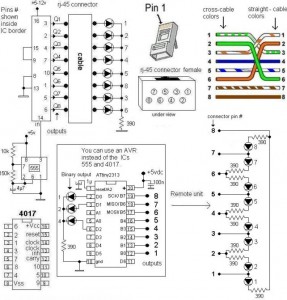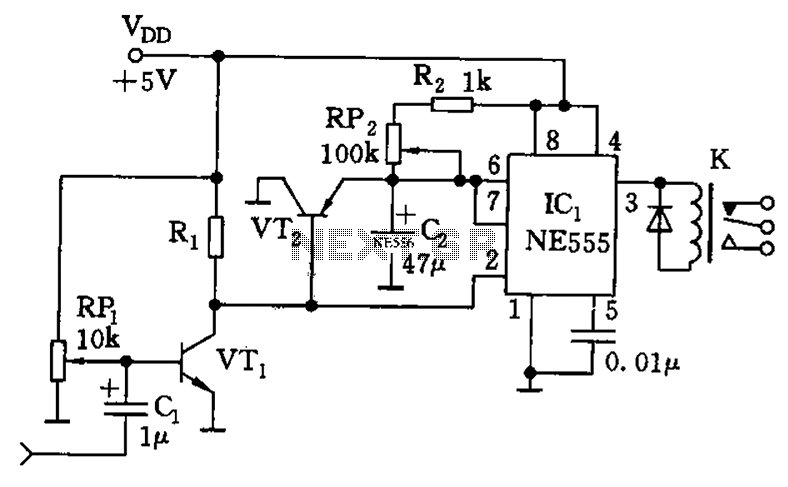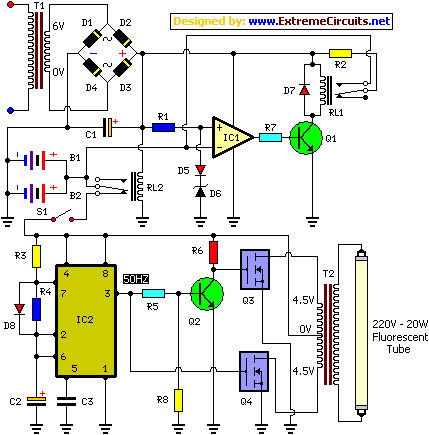
Smoke alarm circuit

The circuit operates using the MQK-2 gas sensor, which detects the presence of combustible gases or smoke through surface adsorption. When gas is detected, the inter-electrode resistance (BL) decreases significantly. This change in resistance affects the voltage at node C, which is determined by the resistors Rp2 and R1 in conjunction with BL. When the voltage at node C drops below one-third of Vcc, the output of IC1 switches to a low state, triggering the alarm to stop.
The circuit utilizes the MQK-2 gas sensor, known for its sensitivity to various combustible gases, including methane, propane, and smoke. The sensor operates by changing its inter-electrode resistance based on the concentration of gas present in the environment. In a typical configuration, the MQK-2 is connected to a voltage divider composed of resistors R1 and Rp2, which helps convert the change in resistance into a measurable voltage at node C.
The critical threshold for activating the alarm is set at one-third of the supply voltage (Vcc). This threshold is established to ensure that the circuit responds promptly to the presence of hazardous gases. When the gas concentration increases, the resistance BL drops, leading to a decrease in the voltage at node C. Once this voltage falls below the defined threshold, the operational amplifier or comparator IC1 recognizes this condition and changes its output state to low, effectively signaling the alarm system to deactivate.
Additional components may be included in the circuit for stabilization and noise filtering, such as capacitors across the power supply lines or additional resistors to fine-tune the sensitivity of the gas detection. The circuit design may also incorporate a hysteresis feature to prevent false alarms due to transient gas concentrations, ensuring reliable operation in varying environmental conditions.
Overall, the circuit serves as an effective gas detection system, utilizing the properties of the MQK-2 sensor and a simple resistor network to monitor air quality and enhance safety by providing timely alerts in the presence of combustible gases.Circuit works: When the gas sensor MQK-2 surface adsorption or smoke when combustible gas, which inter-electrode resistance BL plummeted, this time by the Rp2, R1 and BL electric poles between resistance partial pressure node C potential drop, when it fell to the potential after less than 1/3 Vcc only flip IC1 output low to stop the alarm.
The circuit utilizes the MQK-2 gas sensor, known for its sensitivity to various combustible gases, including methane, propane, and smoke. The sensor operates by changing its inter-electrode resistance based on the concentration of gas present in the environment. In a typical configuration, the MQK-2 is connected to a voltage divider composed of resistors R1 and Rp2, which helps convert the change in resistance into a measurable voltage at node C.
The critical threshold for activating the alarm is set at one-third of the supply voltage (Vcc). This threshold is established to ensure that the circuit responds promptly to the presence of hazardous gases. When the gas concentration increases, the resistance BL drops, leading to a decrease in the voltage at node C. Once this voltage falls below the defined threshold, the operational amplifier or comparator IC1 recognizes this condition and changes its output state to low, effectively signaling the alarm system to deactivate.
Additional components may be included in the circuit for stabilization and noise filtering, such as capacitors across the power supply lines or additional resistors to fine-tune the sensitivity of the gas detection. The circuit design may also incorporate a hysteresis feature to prevent false alarms due to transient gas concentrations, ensuring reliable operation in varying environmental conditions.
Overall, the circuit serves as an effective gas detection system, utilizing the properties of the MQK-2 sensor and a simple resistor network to monitor air quality and enhance safety by providing timely alerts in the presence of combustible gases.Circuit works: When the gas sensor MQK-2 surface adsorption or smoke when combustible gas, which inter-electrode resistance BL plummeted, this time by the Rp2, R1 and BL electric poles between resistance partial pressure node C potential drop, when it fell to the potential after less than 1/3 Vcc only flip IC1 output low to stop the alarm.





